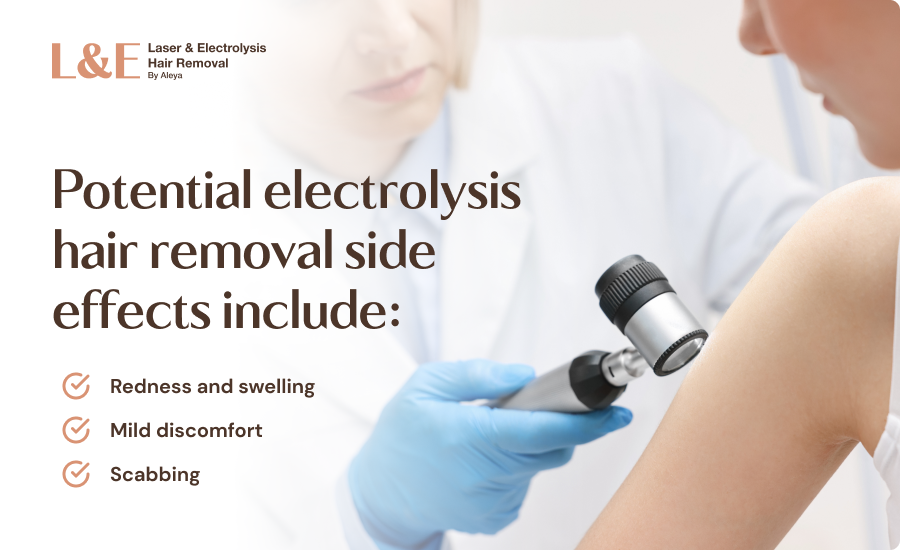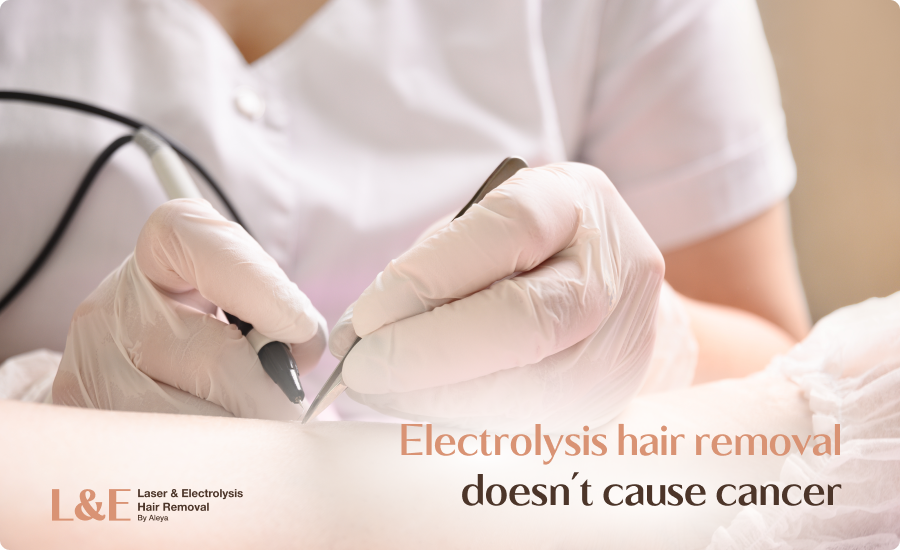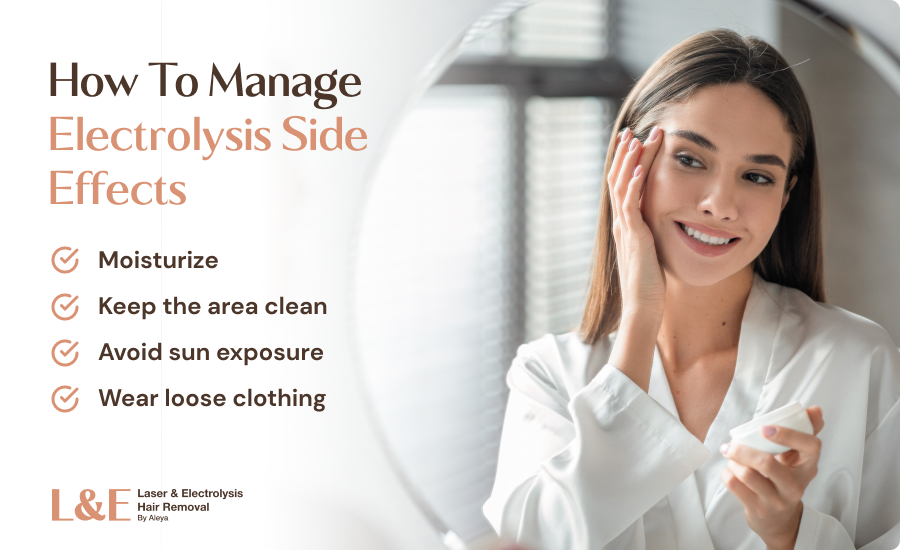10 Common Electrolysis Hair Removal Side Effects

Electrolysis Hair Removal Side Effects: Key Points
- Electrolysis might cause mild irritation, such as redness and swelling, which typically subside within a few hours
- You might notice temporary skin discoloration, including darkening or lightening of the treated area
- Improper technique or inadequate aftercare can increase the risk of infection
If you’re dealing with unwanted hair, electrolysis offers a permanent hair removal solution.
But are there any side effects to electrolysis hair removal?
Yes — electrolysis hair removal side effects depend on the individual, the electrologist’s expertise, and other factors and can include redness, swelling, mild discomfort, and more.
In this article, we’ll:
- Detail the potential electrolysis hair removal side effects
- Offer tips for managing these side effects
- Highlight the safe hair removal services available at Laser by Aleya
Potential Electrolysis Hair Removal Side Effects
While electrolysis is effective and generally safe, it comes with some drawbacks.
- Skin redness and irritation: This occurs when the skin reacts to the needle insertion and electrical current, causing blood vessels to dilate and increase blood flow.
- Burning or stinging sensation: Since electrolysis involves inserting a fine needle into each hair follicle and applying an electric current to destroy the hair root, the heat from the current might cause discomfort, which varies from person to person.
- Dry skin: The heat from the electrical current may strip moisture from the skin, leading to dryness.
- Skin discoloration: Heat from the procedure can temporarily cause changes in melanin. Hyperpigmentation or darkening, occurs when inflammation stimulates increased melanin production. On the other hand, hypopigmentation or lightening of the skin, happens when melanin production decreases.
- Scabbing: Needle penetration can cause small wounds that might form scabs as they heal.
- Infection: Electrolysis can lead to infection if you neglect proper aftercare, as the skin pores stay open and become more susceptible to bacteria. Using unsterile equipment or failing to follow proper sanitation procedures can also transfer bacteria to the client and cause infection.
- Scarring: Incorrect technique or improper aftercare can lead to deep skin trauma and scarring. For example, if the electrolysis needle is inserted too deeply or repeatedly into the same area, it can cause excessive damage to the tissue.
- Blisters: A blister is a painful skin condition where fluid collects between layers of skin. Excessive heat or too strong an electric current can cause blisters.
- Acne: If electrolysis stimulates oil glands or introduces bacteria into the pores, acne might develop.
- Temporary ingrown hair formation: While electrolysis aims to prevent ingrown hair by destroying the follicle, improper aftercare or incomplete follicle destruction can cause hairs to grow sideways into the skin.
Can Electrolysis Hair Removal Cause Cancer?
No, electrolysis hair removal doesn’t cause cancer.
In fact, the Skin Care Foundation notes that the procedure occasionally addresses specific types of precancerous lesions, which are abnormal growths with a higher risk of becoming cancerous.
Research has found no link between electrolysis and an increased risk of cancer. The electrolysis process is free from harmful radiation and doesn’t penetrate deeply enough to cause cancer.

Can Electrolysis Hair Removal Cause Infertility?
No, there is no evidence of electrolysis hair removal causing infertility.
Electrolysis targets only the hair follicles and the immediate skin area, without impacting any reproductive organs.
If you’re trying to get pregnant, consult your doctor and electrologist about any potential risks. In addition, it’s advisable to discuss your concerns and the specific methods used with your electrologist.
How To Manage Electrolysis Side Effects
Here’s what you can do to ease any discomfort and ensure a smooth recovery after your treatment.
- Cool the area: After your electrolysis session, you might notice redness similar to a mild sunburn. Applying a cold compress or ice pack wrapped in a soft cloth directly to the treated area for about 10 to 15 minutes can help reduce this redness and swelling.
- Moisturize: Keeping the skin hydrated is key. Consider using something soothing like aloe vera gel or a gentle moisturizer. Just a light layer over the skin does wonders to help improve healing.
- Avoid sun exposure: Since your skin’s a bit more vulnerable after treatment, try to keep it out of the sun. If you need to be outdoors, slap on some broad-spectrum sunscreen with an SPF of 50 or higher.
- Avoid scratching or rubbing: It’s normal for the area to feel slightly itchy as it heals, but avoid scratching. To prevent infection and further irritation, try to touch the area as little as possible.
- Use anti-inflammatory creams: If you’re experiencing irritation, applying a thin layer of 1% hydrocortisone cream can help.
- Keep the area clean: Use a mild cleanser and lukewarm water to wash the treated area gently. No rubbing — just pat it dry softly with a clean towel.
- Wear loose clothing: If you’ve had work done on larger areas like your legs, opt for loose clothing to prevent any unnecessary irritation from clothes rubbing against the skin.
- Follow aftercare instructions: Whether it’s a special cleanser or specific skin care methods post-treatment, follow your electrolysis’ recommendations.

Can I Undergo Electrolysis Hair Removal?
You might be wondering, are you an ideal candidate for electrolysis hair removal?
Most people can go through electrolysis hair removal safely. However, there are some factors you should consider in determining if it’s the right choice for you:
- Skin and hair type: Electrolysis works on all skin types and hair colors, as it directly targets the hair follicle.
- Medical conditions: If you have conditions like keloids or are prone to skin infections, consult a dermatologist before starting your treatment. Additionally, if you have any implanted medical devices like a pacemaker, discuss potential interference from electrical currents with your healthcare provider.
- Pregnancy: While generally safe, it’s ideal to consider that hormonal changes during pregnancy might affect hair growth and skin sensitivity. Ask your electrologist about the best timing for electrolysis and any precautions you should take during pregnancy.
- Medications: If you’re on medications like isotretinoin for acne, or if you use topical retinoids or steroids, let your electrologist know. These can affect your skin’s healing process and sensitivity.
- Pain tolerance: Electrolysis can be uncomfortable. Talk to your electrologist about pain relief options if you’re concerned about discomfort.
- Time and financial commitment: Keep in mind that electrolysis requires multiple sessions and can be a significant financial investment. Make sure you’re ready for the commitment.
Benefits of Electrolysis Hair Removal
While electrolysis has some shortcomings, it’s important to also consider its significant advantages.
Here’s what you can expect from your electrolysis hair removal session:
- Permanent results: Unlike temporary methods like shaving, waxing, threading, tweezing, and even laser, electrolysis is the only FDA-approved treatment that guarantees permanent hair removal.
- Fewer restrictions: Electrolysis works effectively on most skin and hair types. It’s particularly beneficial for individuals with gray or red hair, which often do not respond well to laser treatments since these hair colors don’t absorb the laser light effectively.
- Prevents ingrown hairs: Electrolysis removes hair and eliminates the problem of ingrown hairs, which can cause irritation, redness, and painful bumps.
Explore Professional Laser & Electrolysis Hair Removal Services at Laser by Aleya
If you’re looking for a permanent solution to unwanted hair, electrolysis is the way to go, as it targets each hair follicle individually for lasting results.
At Laser by Aleya, we offer both laser hair removal and electrolysis, so you can choose the one that fits your hair removal needs best.
Whether you’re drawn to the long-term benefits of laser hair removal or the accuracy electrolysis offers, we’re here to help you get that flawless look you’re after.
![Is Electrolysis Permanent? [+ Key Preparation]](https://www.laserbyaleya.com/wp-content/uploads/2025/02/electrolysis-permanent-hero-image-768x469.png)

![How Much Does Electrolysis Hair Removal Cost in 2025? [+ FAQs]](https://www.laserbyaleya.com/wp-content/uploads/2025/01/electrolysis-hair-removal-costs-hero-image-new-rates-768x469.png)